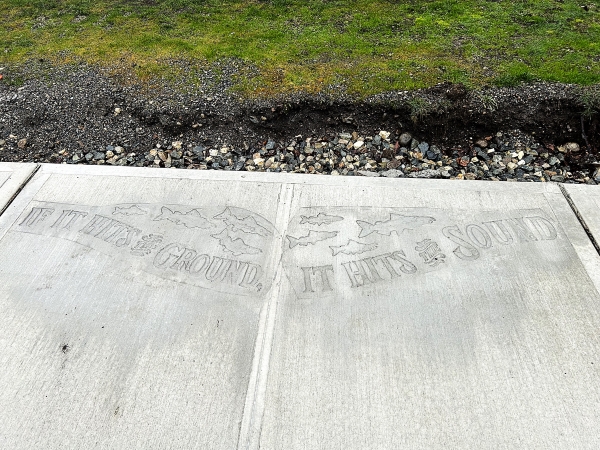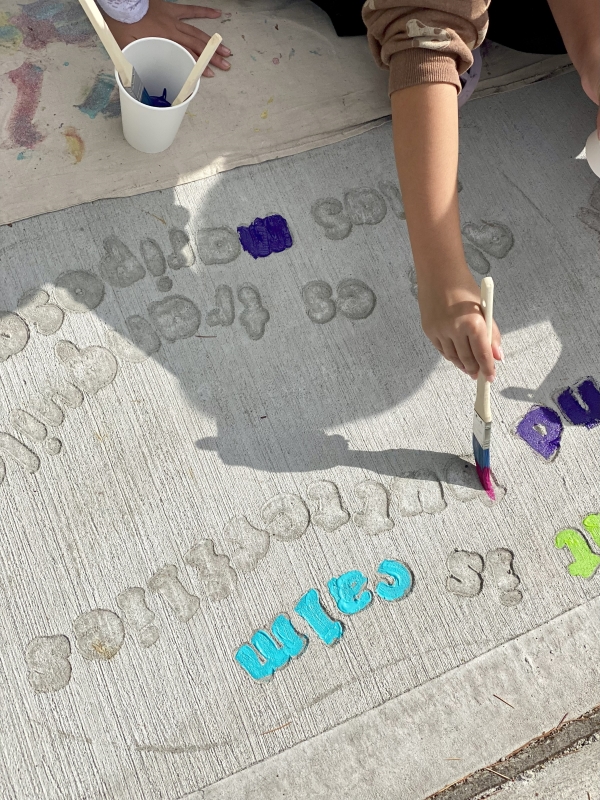
Tacoma's Larchmont Elementary School students wrote poems that were stamped into the sidewalks in Spanish and English.
The City of Tacoma recently completed water quality improvement projects in the Larchmont neighborhood and the Madison District. These neighborhoods are now home to an innovative combination of stormwater management, safer streets, and public art. With more than $6 million in Ecology funding for each project, the work is helping protect and restore water quality in Flett Creek, Chambers Creek, and ultimately, Puget Sound, all while actively engaging and informing the community.
Defining the problem
Before these stormwater improvement projects were completed, both neighborhoods faced deteriorating roadways, a lack of sidewalks and accessible infrastructure, and untreated stormwater runoff that carried sediment, metals, nutrients, oils, and other pollutants into local waterways. Because both neighborhoods lie within the Flett Creek watershed, this runoff flowed directly into Chambers Creek and Puget Sound, posing a serious risk to water quality. In addition, erosion caused by stormwater flows threatened to destroy habitat in Flett Creek and Chambers Creek, both of which are known summer spawning grounds for salmon.
The solution to these challenges? Permeable pavement.
Designing a solution with permeable pavement
Permeable pavement is a stormwater management tool, and a practice known as Low Impact Development (LID). Instead of letting rainwater flow into storm drains, permeable pavement allows it to soak directly into the ground through the roadway. Beneath the surface, layers of rock and soil naturally filter the water, removing pollutants and slowing its flow. This helps support the surrounding habitat by preventing temperature spikes, keeping pollutants from entering the water, and preserving salmon spawning habitat.
Madison District after construction
Sections of traditional roadway were replaced by excavating several feet deep, installing a rock filtration base, and paving the streets with a special porous material designed to let water pass through. In the Madison District, 15 blocks of roadway were replaced with permeable pavement, and in the Larchmont neighborhood, 18 blocks of roadway were replaced. Both projects also improved neighborhood walkability by adding new sidewalks, curb ramps, and over 300 trees along the streets.
"The overall goal was to deliver a project that imrpoved water quality and addressed historical flooding through the installation of permeable pavement, as well as provide broader improvements to the Larchmont neighborhood such as sitewalks, ADA ramps, cyclist accommodations, street trees, and underground utility upgrades," says Jordan Ennis, a City of Tacoma engineer and the project manager of the Larchmont project.
"This project involved partnerships between [Tacoma's] Environmental Services and the Department of Ecology, Public Works, and Tacoma Water, which produced a collaborative approach and significant financial contributions throughout design and construction. The project was a great success and met all the objectives, including finishing construction on budget and ahead of schedule."
Incorporating public art
Since 2000, Tacoma’s Municipal Art Program has dedicated 1% of public capital project construction costs to the creation of public art. This program ensures that major infrastructure projects don’t just improve the environment but also bring culture and creativity into public spaces.
Artistic sidewalk stamps remind passersby, "If it hits the ground, it hits the sound."
Tacoma’s stormwater awareness campaign, “If it Hits the Ground, It Hits the Sound,” is a great example of how the city uses art to creatively and effectively educate the community. In the Madison District, the campaign took shape through sidewalk art stamps carrying this message, reminding residents that everyday actions directly affect local waterways. The Madison project not only reduces runoff through green infrastructure but also shows how creative public messaging can turn everyday spaces into opportunities for education and action.
The City of Tacoma's website shares the following about the project:
"With its unique ability to inspire and educate, art can make complex topics accessible and relatable, helping to engage people around almost any subject. In Tacoma, art is more than decoration, it’s a bridge to understanding and action."
Larchmont Elementary students paint their sidewalk poem
This connection between art, infrastructure, and education was also at the heart of the Larchmont neighborhood project.
Through a series of four classroom lessons, students from Larchmont Elementary School’s Associated Student Body learned about permeable pavement from the City of Tacoma's Environmental Services staff and worked with the Arts and Cultural Vitality Division to write a series of short poems inspired by nature walks around the school.
These poems were stamped into the project’s sidewalks in both English and Spanish. By linking art with infrastructure, this project makes environmental stewardship visible and relatable for the students and neighborhood residents. The Arts and Cultural Vitality Division captured this collaboration in a visual StoryMap.
Together, the Larchmont and Madison permeable pavement projects demonstrate how cities can combine Low Impact Development, community engagement, and public art to enhance neighborhood vitality and protect water quality.
Ecology's clean water funding applications for next year recently closed. We'll announce our draft list of grant and loan awards, including more stormwater projects, in January 2026.

